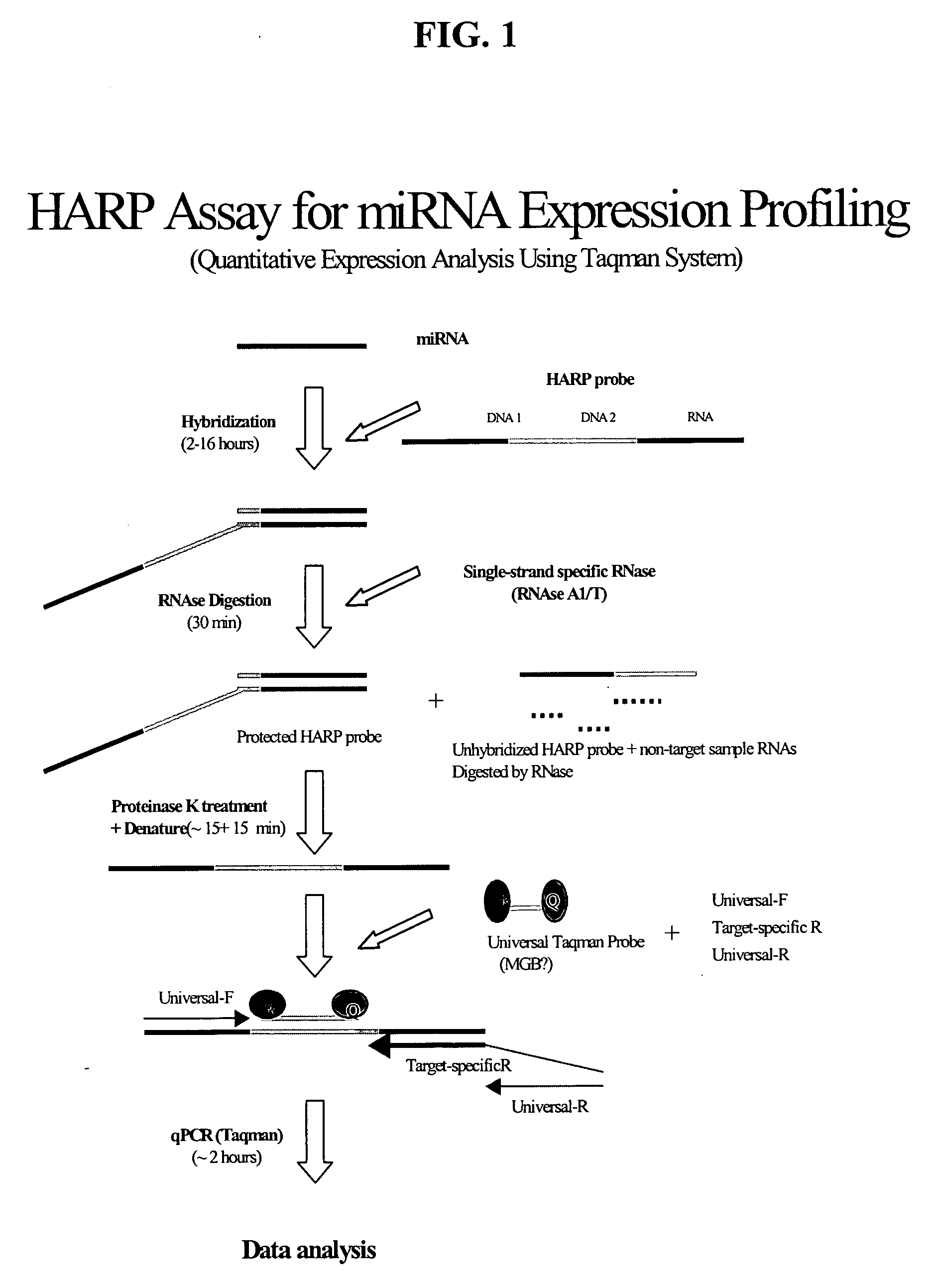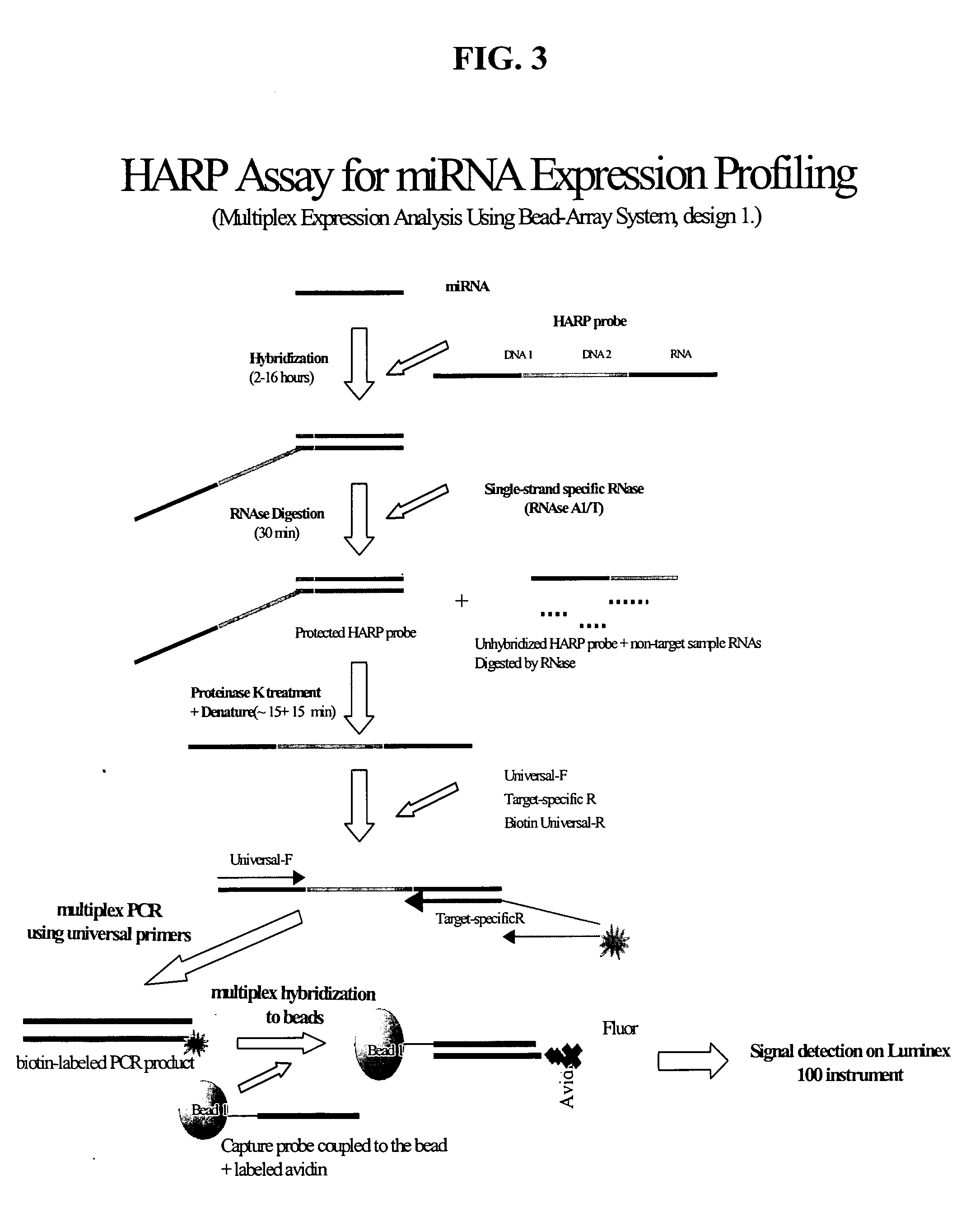Methods and compositions for analyzing nucleic acids
a nucleic acid and composition technology, applied in the field of molecular biology, can solve the problems of labor-intensive and time-consuming northern blot and related methods, inconvenient detection methods, and insufficient or inconvenient detection of very short rnas, and achieve the effect of reducing the problem of bias
- Summary
- Abstract
- Description
- Claims
- Application Information
AI Technical Summary
Benefits of technology
Problems solved by technology
Method used
Image
Examples
example 1
Detection of miRNA Target Using HARP Assay in qPCR™ Format
[0202] Detection of target nucleic acid using the method of the present invention was carried out according to the following protocol.
[0203] A HARP probe was designed to detect a brain-specific miRNA (miR-124) and consisted of a 71 base chimeric oligonucleotide having the following sequence:
5′ CTTTT CCCGT CCGTC ATCGC TCAAG(SEQ. ID NO:4)TGGCATTCAC CGCGugcCTTAACTC CCTAT AGTGA GTCGT ATTAC G 3′
[0204] The HARP probe is chimeric in the sense that is contains DNA bases and RNA bases (RNA bases are shown in lowercase). The features of the HARP probe, from 5′ to 3′, are a first Amplification Region (position 1-19 comprising a Forward primer binding site); a Detection Region (position 20-34 comprising a 15 base TAQMAN probe-binding site); a 22 base Target Hybridization Region (position 26-47, underlined, comprising 22 bases that are complementary to miRNA); a Probe Inactivation Region positioned within the Target Hybridization Regi...
example 2
Detection of miRNA Target Using HARP Assay in qRT-PCR Format
[0213] To demonstrate the use of a HARP probe to detect miRNA in a qRT-PCR format, a HARP probe was designed with additional RNA bases, requiring a reverse transcription of 10 RNA bases. The HARP probe served the same purpose: to detect a brain-specific miRNA (miR-124) and consisted of a 71 base chimeric oligonucleotide having the following sequence (RNA bases shown in lower case):
5′ CTTTT CCCGT CCGTC ATCGC TCAAG(SEQ. ID NO:8)TGGcauucaccgcGTGCCTTAACTC CCTAT AGTGA GTCGT ATTAC G 3′
[0214] The primary features of the HARP probe, from 5′ to 3′, are a first Amplification Region (position 1-18 comprising a Forward primer binding site); a Detection Region (position 19-37 comprising a 19 base TAQMAN probe-binding site); a 22 base Target Hybridization Region (position 26-47, underlined, comprising 22 bases that are complementary to miRNA); a Probe Inactivation Region (position 29-38 comprising 10 bases of RNA, shown in lower case)...
example 3
Sensitivity and Linearity for Detection of miRNA in Human Sample
[0223] To demonstrate the sensitivity and linearity of detection of miRNA in a human sample, a HARP assay was carried out as described in Example 1, except that HARP probe was hybridized overnight using 3 different amounts of total RNA (100 ng, 10 ng, and 1 ng) from human brain as target. The miR-124 target was detected with Ct values shown in Table 1 below. Note, a difference of 3.3 between two Ct values reflects a 10-fold difference in amount of target. This study demonstrates linear detection of the miR-124 target RNA between 100 ng and 1 ng; the minus-target-plus RNase control reaction did not show any amplification, showing that amplification of the HARP probe was target-dependent.
TABLE 1Amount of human brain RNACt value for miR-124detection viainputHARP assay100 ng21.74 10 ng25.24 1 ng28.84Nonenot detected
PUM
| Property | Measurement | Unit |
|---|---|---|
| Length | aaaaa | aaaaa |
| Concentration | aaaaa | aaaaa |
Abstract
Description
Claims
Application Information
 Login to View More
Login to View More - R&D
- Intellectual Property
- Life Sciences
- Materials
- Tech Scout
- Unparalleled Data Quality
- Higher Quality Content
- 60% Fewer Hallucinations
Browse by: Latest US Patents, China's latest patents, Technical Efficacy Thesaurus, Application Domain, Technology Topic, Popular Technical Reports.
© 2025 PatSnap. All rights reserved.Legal|Privacy policy|Modern Slavery Act Transparency Statement|Sitemap|About US| Contact US: help@patsnap.com



